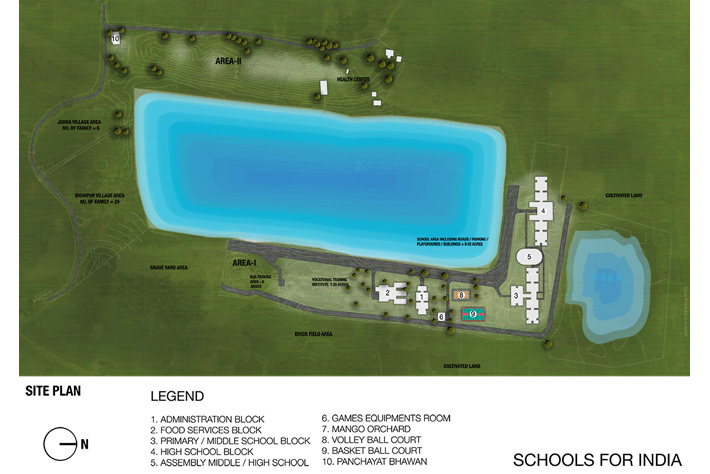PDFs

Schools for India
‘Schools for India’ trust is primarily engaged in building and running schools in rural India. The proposal is to build 6000 schools across India in 610 districts, along with setting up a network of volunteers across the country for volunteers to provide ideas, skills and teaching materials for schools. The first school is proposed to be set up in the Dharbanga District of Bihar. Clustering 20 odd villages in an economically backward area in Dharbanga, with the participation of the village elders and panchayats, the land was identified and donated to a trust set up locally to undertake a phased development of 12 schools for over 3000 children. This is to be coupled with vocational training centres for innovative livelihood options like designing and manufacturing e-cycles, low fuel cooking stoves and paramedical training.
The school is designed as clusters of buildings with exposed bricks and terracotta tube roofing vaults. Historically towns, forts and palaces in this part of Bihar have been built with exposed bricks as there is rich tradition of craftsmanship in terracotta as the soil is excellent for it. But as the climate is a composite with very hot summers, cold winters and long monsoons, it was decided to make the roof with a new technique of terracotta tubes that would insulate the spaces from the direct heat or cold. Given the local traditions with clay work, introducing this new technique would also provide them with new technology for roofing the village houses.
The school is set on the excavated soil mounds around the village pond facing the fields, making it the centre of their lives. The openings are deep set between fins to shade them from the harsh sun and the long monsoons, making the indoor spaces comfortable.
Each school will consist of:
• Kinder Garten
• Primary School
• High/Middle School
• Secondary School
• Special Children School
• Library
• Vocational Training Center
• Physical Training Center, Sports field and Stadium
• Rural Economic Zone- Periphery
• Family Health Center-Periphery
• Environmental Education Center of Excellence- Water Shed, Indigenous Plants, and Bio-studies.
• Community Center
• Kitchen and Dining for Catering to 500 Students at a time, doubles up as Community Kitchen Center
• Media Center-FM Radio
The school is designed to accommodate around 1000 students per shift. The shifts are designated as, primary shift for regular students, second shift for drop-outs who could not pursue their studies due to various reasons, and third shift is for those who are working. The second and third shift will run for two hours each and will provide bridge courses for the students. The older students are expected to undergo on-the-job training in the rural economic zone which will be created as part of the school campus.
Project list:
Experimental
Public (Education)
- Auroville Library
- AVM Environmental and Vocational training centre
- Goa International school
- Gurukul School, Kerala
- Illangarkal School
- Kindergarten, Auroville
- New Era Senior Secondary school
- Schools for India
- Yellow Train School
- Centre For Green Revolution
Public (Hospitality)
Public (Institutional)
Residential
- Harmony farmhouse
- Humanscapes
- Humanscapes 1A
- Humanscapes 1B
- Minoti house
- Narendra beach house
- Prarthana housing project
Planning
